Electric fence netting is one of several temporary fence options to use with goats (and sheep) when grazing on pasture or managing brush. It’s an easy way to start grazing pasture without spending extra time and money on permanent fencing infrastructure.
I may earn affiliate income from links in the blog post, including through the Amazon Associates program as well as other brand partnerships. I only promote products I actually use in my farm and business.
Table of contents
What is electric net fencing?
Electric net fencing is a style of fence made of plastic stays and polywire with posts every 6 to 12 feet, depending on the style of fence.
It is often called electronet fencing, electric net, or net fence.
Electric fence netting is primarily used with smaller livestock, including goats, sheep, hogs, and chickens.
Electric netting fence features
While there are numerous types of electric netting fence, you’ll find these common characteristics:
- Square openings, which vary in size depending the style of electric netting and the type of livestock or wildlife it’s designed to be used with.
- Posts every 6 to 12 feet with single or double spikes. Some posts are poundable with a mallet.
- Fence height varies on its purpose, 20-68 inches
- Length of rolls ranges from 50 feet to the standard 164 feet
Other equipment needed
Besides the electronet fencing you’ll also need the following equipment to use it with your goats:
- Energizer – right-sized to your fence type and a number of fences
- Grounding rods – typically 3 feet of rod per joule rating on the energizer used
- Jumper/ alligator cables to connect fences and the energizer
How to set up electronet fencing
- Prepare the site: Either mow a path in the grass or beat down a path with the wheels of your UTV or ATV
- Layout the electronet fencing flat where it will be put up, then go back and put in the posts.
- Once all the net fences are up, they can be connected together at the end with the metal clips. They do not need to be connected as a continuous circle.
- Connect the electric goat netting to the energizer and turn on
- When taking down the electronet, turn off the energizer, then pull out the posts and lay the fence down on the ground. Do not roll up the fence. Pick up the posts in a “stacked fashion,” then the fence can be rolled up and tied with a string to keep it from getting tangled.
Just like any other electric fence, it’s always important to train your goats to respect the fence and make sure they always have enough to eat in a paddock to avoid any issues of jumpers, animals getting caught or other problems. Get my free electric fence training guide for goats here.

Using it with goats and sheep
On our farm, Cylon Rolling Acres, electric fence netting is our preferred option when building temporary paddocks outside our permanent goat pasture with an existing fence.
Primarily we’re using it in our woods for grazing brush and to graze other areas of our farm where we don’t have goat fence.
Net fence gives me the piece of mind when we graze our sheep and goats for these reasons:
- It is less permeable compared to a multi-strand electric fence setup, so it’s less likely that a goat or sheep will get out of the paddock if the energizer stops working or is grounded out. It also means that it’s less likely a predator will try to get through it or crawl under it. Of course, keeping it electrified will help with that, as well as using livestock guardians.
- We’ve found it to be more durable with wildlife that moves through our woods. If a deer jumps the netting, it may knock down a post or break part of the top of the netting, but the whole fence doesn’t go down. In the past when we used polywire, often the wire would break or get pulled out, leaving a larger opening for livestock or guardian animals to get out, or predators to get in.
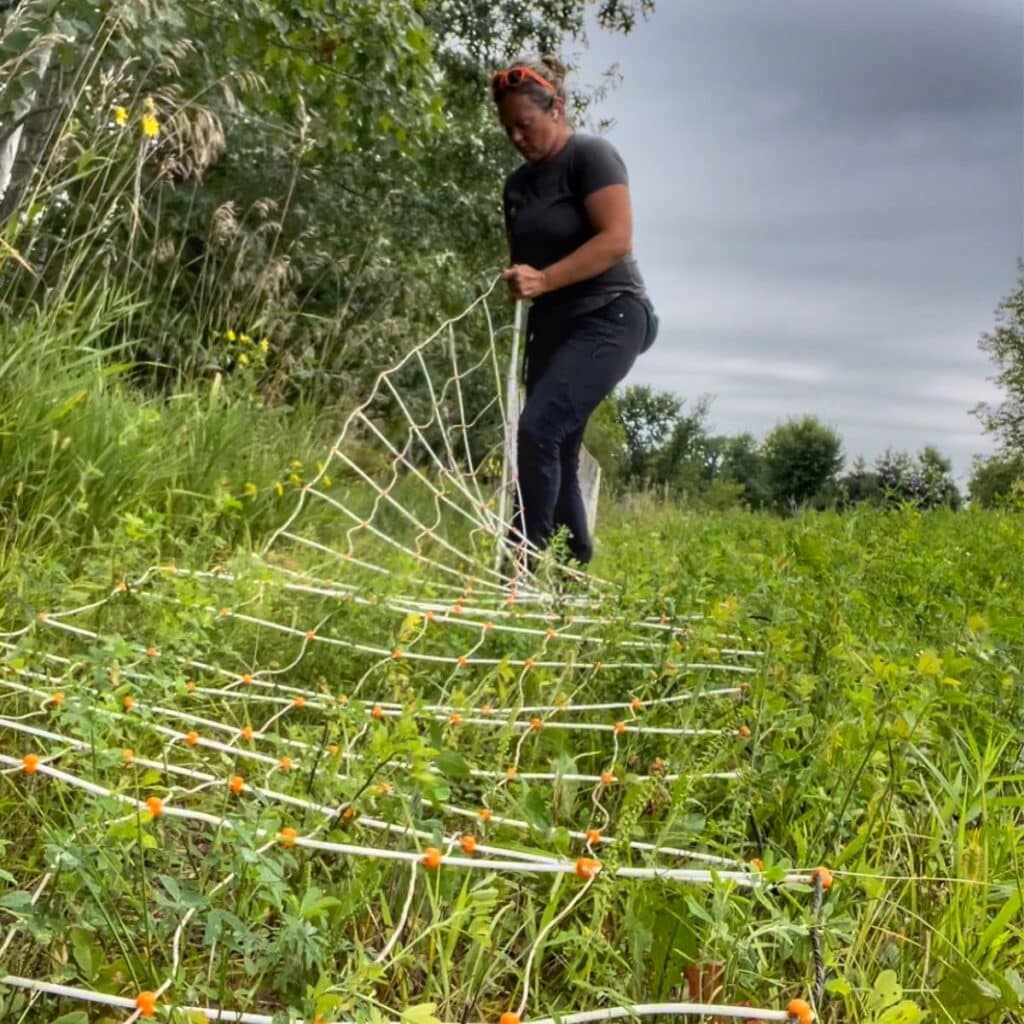
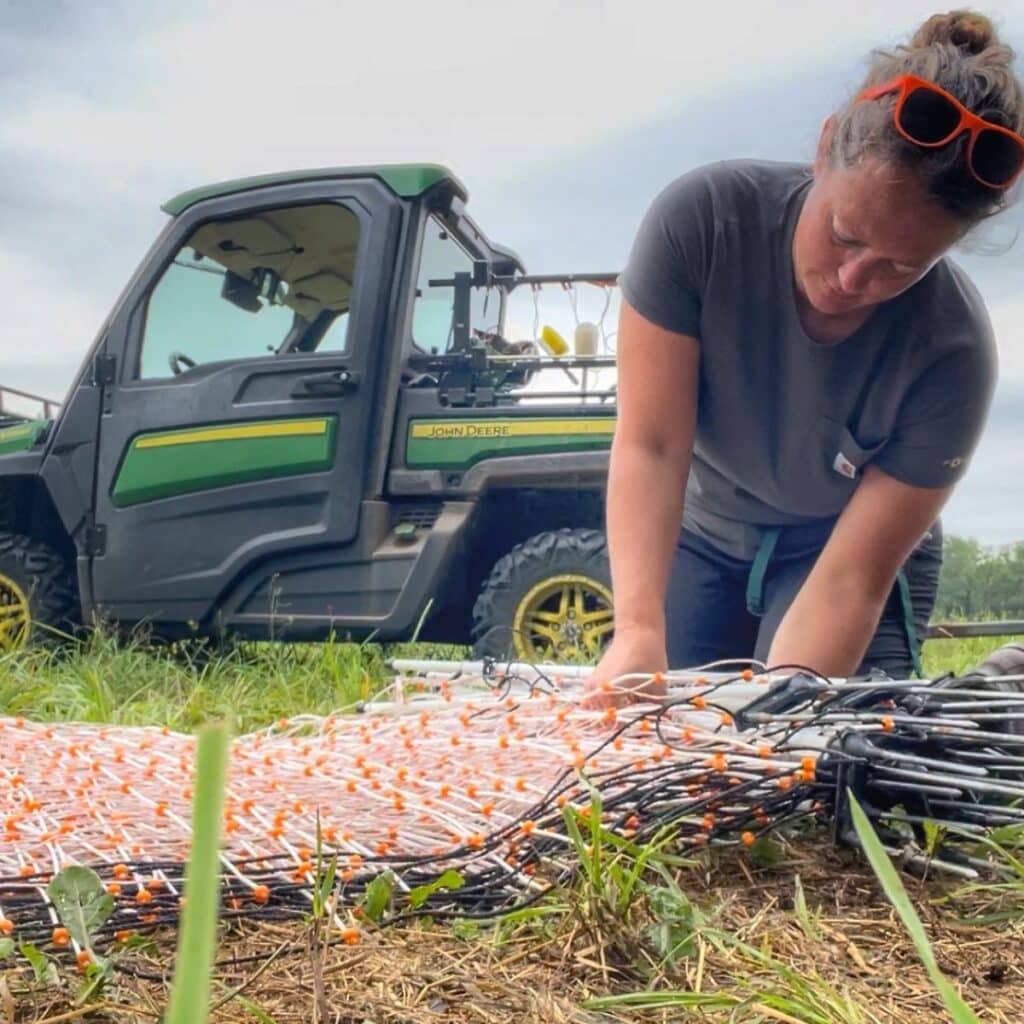
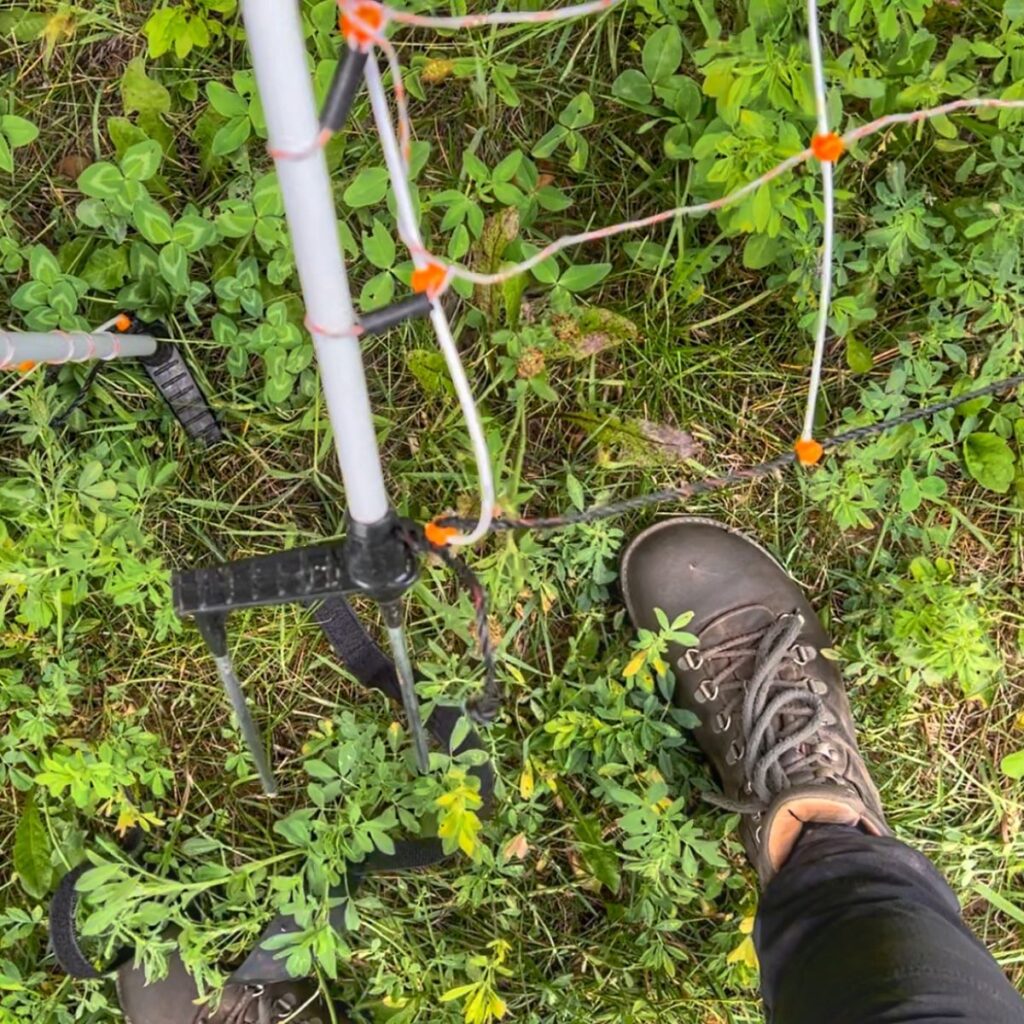
Electronet challenges
The downside of the fence is setting it up, taking it down, moving it, and transporting it.
However, if you take your time to lay it down, fold it by the posts, and tie it together at the posts, it can make the process and experience pretty easy. Otherwise, it will become a tangled problem. We also use a trailer where we’ll lay our fencing down flat and stacked, and it seems to help make moving the fence that much easier.
I wouldn’t recommend rolling the netting up unless it’s already folded, and tied, and then you can roll it up. Due to the easiness of getting posts tangled, I will usually only roll it up when I’m storing the fence for the off season or needed to make room to transport it long distances (such as off the farm or fields farther away).
The best place to buy
This summer we tried out Gallagher’s Turbo Electric Sheep Netting and really like their net fencing as well. If we need to add more net fence to our fencing supplies, I will likely purchase more from them.
A few of the features I really like:
- Step-in posts with two spikes and a foot grip, making it easier to push in
- Velcro carrying handles that also double for connecting multiple fences together
- Use of turbo wire over the standard poly wire, which is way more conductive (in maintaining the electrical current), 46x stronger – this means it’s more reliable in keeping goats, sheep, and guardian dogs in and predators out
You can learn more about this style of fence in the video below. If you’re interested in trying it out yourself, you can order it here and use the code CYLON for 10% off your entire order.
Electric net fence safety
It’s important to always exercise caution around electric net fencing. Turn off the energizer before working on the fence or stepping over a fence to avoid any issues of becoming tangled or getting shocked.
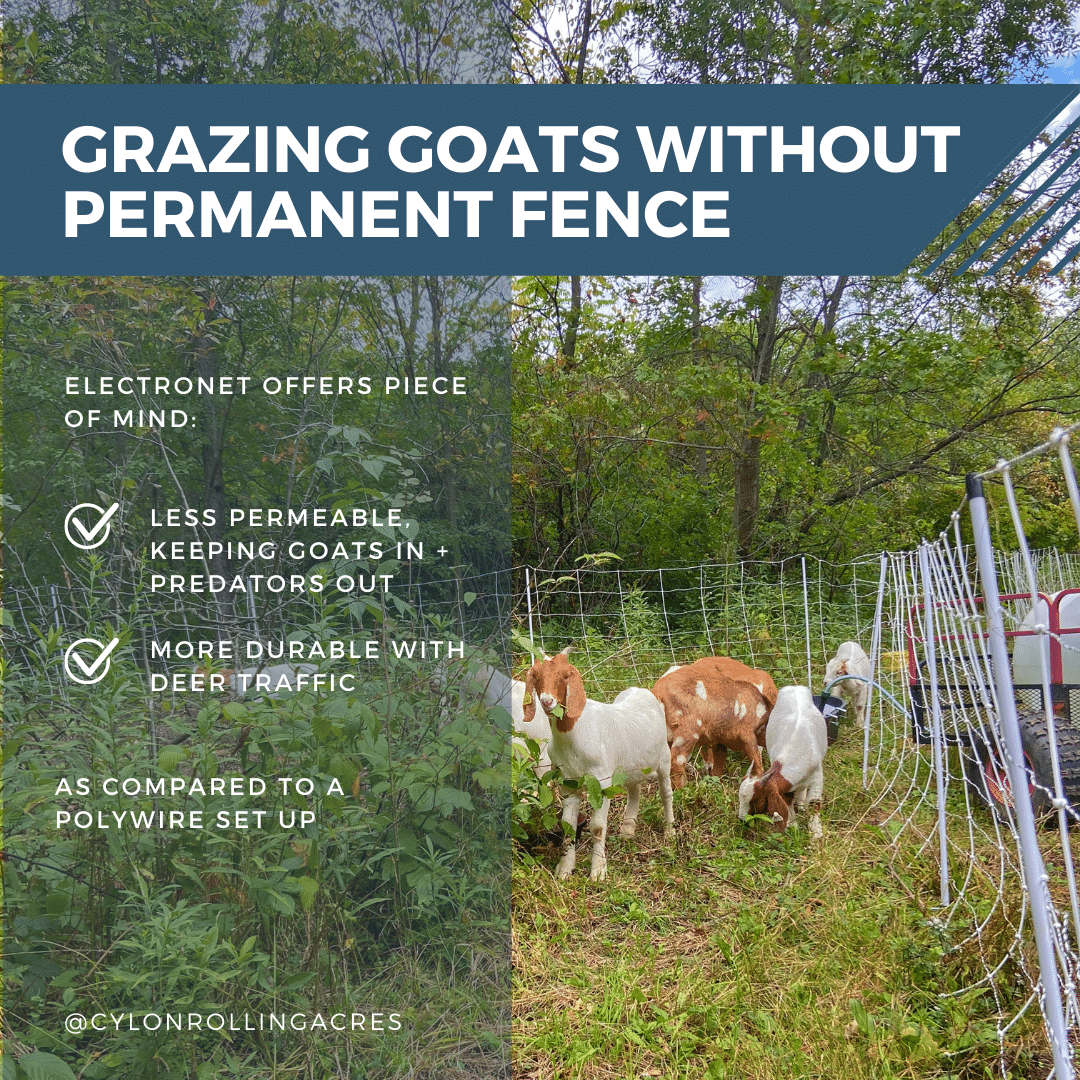
FAQs
Tangles can happen, but it’s also important to fence train a herd/flock to electric fence so they know to respect it, including understanding how it works to minimize getting tangled or breaking out. We retrain and train new/young goats at the beginning of every grazing season. It makes a big difference with issues. If you’re interested learning more I have a reel on fence training & a more comprehensive training Also keep it on and hot!
Tangling when putting it up, taking it down, and storing it. I forgot to mention this in the Q&A, but this can also be when the fence will tangle. It’s really important to move the fence by “folding it” and do not roll it until it is folded. We actually try not to roll it at all possible. To fold it from being up, I will go through and take each post out and lay the fence down on the ground. Then I go through and pick up one post at a time, stacking them on top of each other with the net folding/hanging down.
We then will tie the posts together to store flat on a trailer when we move the fences. My husband likes to pull the posts and “stack” them as he takes the posts out. I prefer the other just because it’s easier for me to handle the fence in that manner.
You can connect an electric fence charger to netting by using a terminal wiring harness, which is an insulated wire with an alligator style clip on one end and a raw/exposed wire on the other end.
The exposed wire will typically go into the positive terminal on your energizer. Always consult the manufacturer manual for your energizer.
If you don’t have one or it broke, you can order a terminal wiring harness replacement online. (affiliate link)
To install electric net fencing unroll, laying the fence flat in the location where you’d like to use it. Then put each post in the ground so the netting is pulled tight.
If you plan to use multiple net fences, connect them by sliding the metal end clips together. It also helps to tie the posts together with the strings that come with the fences.
Then connect the fences to the energizer.
You can repair electric net fence by using a repair kit which typically comes with any net fence from most manufactures. You can also use other polywire and supplies you might have on hand as well.
To repair, turn off the power source and tie on the replacement wire to where the wire is broke. Repeat on the other side of the break. It’s recommended to use a metal band over the tied wire.
Post originally published October 2021.
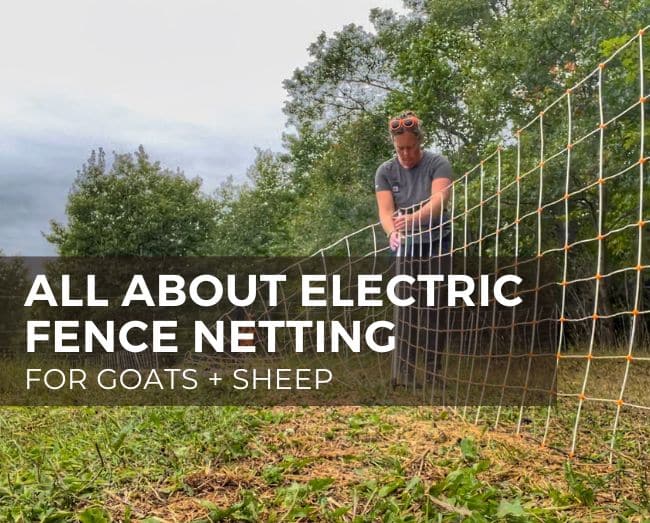
LEAVE A COMMENT
Comments